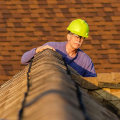Are you planning to do a DIY home inspection? Home inspections are important when buying or selling a property, as they can reveal potential issues with the property that may not be immediately visible to the naked eye. Knowing what to look for and how to properly inspect a home can save you money and time in the long run. In this article, we'll provide tips on how to do a DIY home inspection, and what to look out for. We'll also provide guidance on how to interpret the results of your inspection.
Doing a DIY home inspection
can be a daunting task, but it doesn't have to be.With the right knowledge and tools, you can confidently inspect your home for safety and soundness. In this article, we'll provide you with tips and advice on how to do a successful DIY home inspection of your own. When doing a DIY home inspection, it's important to understand what to look for and how to identify any potential issues. Start by familiarizing yourself with the basics of home inspection, such as what to look for in a roof or foundation, and what to look out for in electrical or plumbing systems.
Knowing what to look for will help you identify any potential problems that could arise. Next, you'll want to assess the condition of each room of the house. You should look for any signs of damage or wear, such as water stains, cracks in walls or ceilings, or other signs of deterioration. Additionally, look for any signs of pest infestations, such as droppings or gnaw marks. Once you've completed the initial assessment of the house, you'll want to perform a more detailed inspection of each individual system. This includes inspecting the roof, foundation, HVAC system, electrical system, plumbing system, and any other systems in the home.
Pay close attention to any potential signs of damage or deterioration, such as missing shingles or cracked foundation walls. In addition to inspecting the systems of the home, it's important to inspect all visible pipes and wiring for any signs of damage or wear. Additionally, check for any signs of mold or mildew, which can indicate moisture intrusion. Finally, it's essential to check all smoke detectors and carbon monoxide detectors throughout the house. This will ensure that these devices are in good working condition and can alert you in the event of an emergency. Once you've completed your inspection, it's important to document any findings in detail. Take photos or videos of any issues that you find, and make sure to note any repairs that may be needed.
Additionally, make sure to keep all documentation organized in case you need to refer back to it in the future.
Safety Tips for Doing a DIY Home Inspection
When doing a DIY home inspection, it's important to keep safety top of mind. Make sure that you have all necessary safety equipment such as goggles and gloves. Additionally, be sure to use ladders safely and take all necessary precautions when working with electrical systems. Inspecting electrical systems can be especially dangerous, so it is important to turn off the power before inspecting and testing any wiring or outlets.Be sure to use a voltage tester to ensure that the power is off before you begin. Additionally, make sure that all electrical connections are secure and that there are no frayed wires or exposed wiring.
Tools and Equipment Needed for a DIY Home Inspection
When conducting a DIY home inspection, there are several tools and equipment that you'll need. This includes a flashlight, ladder, tape measurer, level, extension cord, and various hand tools such as screwdrivers and pliers. Additionally, you may want to purchase an infrared thermometer or other specialized tools if needed.A flashlight is important when inspecting dark corners, crawl spaces, and attics. This will allow you to see potential issues that may not be visible with the naked eye. A ladder is also necessary for inspecting hard-to-reach areas such as roof eaves and chimneys. A tape measurer can help to accurately measure the size of the rooms and ceilings, while a level can be used to check if walls and ceilings are even.
An extension cord can be useful when inspecting outlets, switches, lights, and appliances. Finally, hand tools such as screwdrivers and pliers can be essential when disassembling panels or other components in order to inspect them. In some cases, you may also need additional tools such as an infrared thermometer or moisture meter. These specialized tools can be useful when checking for issues such as water damage or insulation problems. Doing a DIY home inspection can be a challenging but rewarding task.
By following the tips and advice on how to do a successful DIY home inspection of your own, you can ensure that your home is safe and sound. Remember to use the proper tools and equipment needed for a DIY home inspection, as well as the safety tips for doing a DIY home inspection, in order to make sure that you have a successful DIY home inspection.






